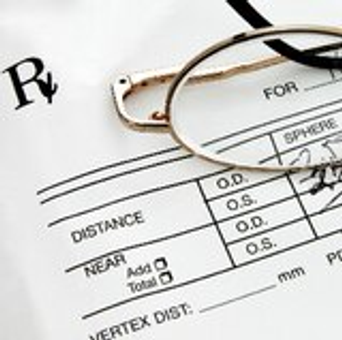Contact lens prescriptions contain specific information to ensure that contact lenses are safe, comfortable, and provide optimum vision. Since eye contact prescription lenses must match the shape and size of an eye, it is important that information like base curve, diameter and brand are contained in a prescription.
How to Read an Eye Prescription?
Eye care practitioners use standard terms, abbreviations, and measurements to write contact lens prescriptions. You have probably wondered what the incomprehensible scribbles of your ophthalmologist mean and if you could ever learn to decipher them. You may not need to know all of the abbreviations and numbers in your optical prescription. However, learning how to read eye prescriptions, at least the basic terms, is useful, especially if you shop online.
Left and Right Eye Abbreviations (OS vs. OD Contacts)
The letters OS and OD can be found along the top or side of any contact lens prescription. The left eye medical abbreviation is from the Latin term “oculus sinister,” which means left eye, and OD comes from the term “oculus dexter,” which means right eye. You can just remember OD vs. OS eye abbreviations for the right and left eyes, respectively. Sometimes, you can also encounter the letters OU on your contact lens prescription, which is short for “oculus uterque” or each eye, meaning the same measurement applies to both eyes.
What Does Power Mean for Contacts?
PWR means refractive power, but sometimes it can be abbreviated as SPH (sphere). This is the amount of vision correction, measured in diopters, needed to bring your vision to 20/20 – or as close as possible. If this number is preceded by a minus sign, you are nearsighted. If there is a plus sign before the number, you are farsighted. The further the number is from zero, the stronger your prescription. It is common to have different prescription contact lenses in each eye. A contact lens power chart reveals the refractive power required to convert glasses prescriptions to their corresponding contact lens range.
What Does the Base Curve of Contacts Mean?
BC, or base curve, is the back curvature of the contact lens measured in millimeters. This number is usually between 8 and 10 and is important for the fixing of your prescription contacts because it will match up with the curvature of your cornea. If your prescription doesn’t include a BC, it’s likely because the base curve contacts the brand prescribed only comes in one base curve.
Knowing a Contact Lens Diameter
Diameter or DIA is the distance across the surface of the contact lens measured in millimeters. The contact lens diameter determines where the contact lens will sit on your eye. The figure is usually between 13 and 15, and if the measurement isn’t correct, the contact lens will be uncomfortable and may scratch your eye.
Bifocal, Multifocal, and Toric Contact Lenses
Bifocal and multifocal contact lenses provide clear vision at all distances for those who have refractive errors and are experiencing age-related vision decline. They provide ADD – added magnifying power (in diopters) in portions of the lens to help with seeing up close.
Bifocal contacts have two prescriptions in a single lens, one for seeing up close and the other for seeing far away.
Multifocal contacts have a range of power for seeing up close, far away, and every distance in between.
Toric contact lenses are shaped in a specific way to help correct astigmatism. If you wear toric lenses, your prescription will contain abbreviations like CYL and Axis. CYL is a cylinder value, and it’s usually a number between -4 and +4. This is the amount of power needed to correct your astigmatism. Axis expresses the orientation of the cylinder value on the lens. This number is displayed in degrees, between 0 and 180°.
A Note on Pupillary Distance (PD)
Your pupillary distance on prescription is the distance in millimeters between the center of your pupils (the black point in the middle of your eyes). The PD indicates where you’ll be looking through the lens of your glasses. It’s important to measure PD eye prescription correctly as inaccuracies can lead to eyestrain and distorted vision. Your optician will measure PD when fitting you for glasses.
Additional Information Present on a Contact Lens Prescription
The contact lens brand(s) or materials must be specified on a contact lens prescription because each lens material has a specific degree of oxygen permeability. This is especially important if you want extended wear contact lenses or you occasionally fall asleep while wearing your contacts.
There are many types of contact lenses, daily contact lenses – single-use lenses that are discarded and replaced at the end of each day. Weekly contacts are designed to be used for a week or two before they are disposed of. Monthly contacts may be worn for about 30 days before they are replaced.
Generally, a contact lens Rx is valid for one year. You will need to revisit your eye doctor when your prescription expires for a checkup of the health of your eyes before you can purchase additional lenses. Eyeglass prescriptions are regulated under state law, and most expire after two years.
If you choose to cosmetically enhance your eye color with your lenses, that information will also be on the prescription. In some cases, the prescription also includes how often to replace the lenses (whether they are daily, weekly, monthly or longer).
Are Contact Lens and Glasses Prescriptions the Same?
Contacts and eyeglass prescriptions are not the same. Even if you already have a glasses prescription, you will need a separate contact lens prescription before getting contacts. These two types of prescriptions are significantly different because eyeglass lenses are positioned approximately 12 millimeters from your eyes, whereas contact lenses rest directly on the surface of your eyes.
What’s the Difference Between Contact Lens and Glasses Prescriptions?
Contact lens prescriptions differ from glasses prescriptions. Contact lens prescriptions contain specifications that are not included on a glasses prescription that can only be determined after a comprehensive contact lens exam and fitting. The additional specifications that aren’t included on glasses prescriptions include base curve (BC), diameter (DIA), lens brand and material, as well as an expiration date.
Eye doctors will often apply the same prescription for glasses, so you probably know how to read a prescription for glasses if you can read your contact Rx. If you wonder how to find out what prescription your glasses are, you can request your details from the last place you took an eye exam or take an at-home vision test and receive a prescription within 24 hours. If you have an existing prescription, you can also get your Rx information by using a smartphone app.
Can You Get Contact Lenses Without a Prescription?
The purchase of all contact lenses can’t be made without a valid contact lens prescription written by a qualified ophthalmologist. Buying or selling contact lenses without a valid prescription is illegal - this includes both colored and special-effect contact lenses that are used for cosmetic purposes only.
Contact lenses are medical devices and can cause discomfort, infection, inflammation, swelling, and in rare cases, permanent eye damage if fitted and used inappropriately. This is why you need a prescription from your eye doctor, who can only write you a contact lens prescription after a thorough exam and fitting.
Sharing contact lenses, whether they be colored or theatrical ones, is very dangerous since it can potentially cause sight-threatening eye problems.
Can Your Prescription Expire?
Contact lens prescriptions are valid for a minimum of one year per federal law. When it expires, you are required to visit your eye care doctor in order to update your prescription. This will involve an eye exam to see your general eye health and check whether your contact lenses are still good for your eyes. Often during an eye exam, doctors notice something that could cause a problem if not taken care of immediately. In many cases, a change of contact lens type or contact lens solution can solve a problem.
Where Can You Use a Contact Lens Prescription?
Once you’ve obtained a valid contact lens prescription, you can purchase contact lenses from a wide variety of sources. This means that you can buy lenses from your eye care practitioner, optical chains, mass merchandisers, and online discount contact lens retailers, but make sure you buy them from a legitimate source.
Ready to Buy?
Now that you know what the terms on your eye prescription mean, are you ready to shop? You can order contact lenses and glasses online. Your contact lens or glasses prescription is not a one-for-all-time solution. Your vision needs may change with time, so it’s necessary to see a specialist at least once every two years. If you require further guidance, do not hesitate to get clarification from your eye care specialist.
FAQs
Can I still wear glasses if I get lenses?
You can wear glasses and lenses at the same time to fix multiple vision issues. The glasses may help with farsightedness, while the contact lenses help you read.
Why do I need a prescription for contact lenses?
Contact lenses are visual orthotics, and only a professional can tell you if you need them. After a professional examination, the optician or optometrist will help you determine contact lenses most suited to your lifestyle and needs.
What are OD vs. OS eye contacts?
OD vs. OS are right and left eye abbreviations found at the top of a contact lens Rx. OD is the Latin term “oculus dexter,” meaning right eye, while OS is “oculus sinister," meaning left eye.
How do I know what prescription my glasses are?
You can know what prescription your glasses are by requesting it from your last eye care provider, taking an at-home vision test or using a mobile app.
Are glasses prescriptions the same as contact lens prescriptions?
Glasses prescriptions differ from contact lens prescriptions in the details they contain. Contact lenses prescriptions contain additional specifications not found on a glasses prescription, including diameter, base curve, lens brand or material, and expiration date.
Can I wear contact lenses if I wear bifocal or multifocal glasses?
There are different types of bifocal and multifocal lenses. You can wear a contact lens for near vision in one eye and a different type for far vision in the other.
What is the importance of the contact lenses diameter?
The diameter of a contact lens is important because it determines how well the lens will fit the eye. A contact lens that doesn’t fit well can lead to discomfort and even medical complications.
 Save yourself from getting into rush hours and buy your contacts online.
Save yourself from getting into rush hours and buy your contacts online.








